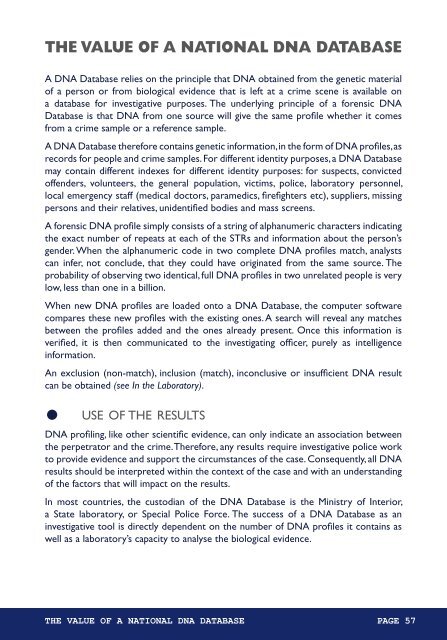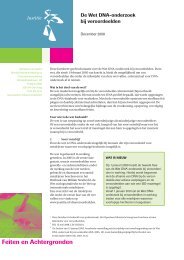INTERPOL HANDBOOK ON DNA DATA EXCHANGE AND PRACTICE
INTERPOL HANDBOOK ON DNA DATA EXCHANGE AND PRACTICE
INTERPOL HANDBOOK ON DNA DATA EXCHANGE AND PRACTICE
You also want an ePaper? Increase the reach of your titles
YUMPU automatically turns print PDFs into web optimized ePapers that Google loves.
THE VALUE OF A NATI<strong>ON</strong>AL <strong>DNA</strong> <strong>DATA</strong>BASEA <strong>DNA</strong> Database relies on the principle that <strong>DNA</strong> obtained from the genetic materialof a person or from biological evidence that is left at a crime scene is available ona database for investigative purposes. The underlying principle of a forensic <strong>DNA</strong>Database is that <strong>DNA</strong> from one source will give the same profile whether it comesfrom a crime sample or a reference sample.A <strong>DNA</strong> Database therefore contains genetic information, in the form of <strong>DNA</strong> profiles, asrecords for people and crime samples. For different identity purposes, a <strong>DNA</strong> Databasemay contain different indexes for different identity purposes: for suspects, convictedoffenders, volunteers, the general population, victims, police, laboratory personnel,local emergency staff (medical doctors, paramedics, firefighters etc), suppliers, missingpersons and their relatives, unidentified bodies and mass screens.A forensic <strong>DNA</strong> profile simply consists of a string of alphanumeric characters indicatingthe exact number of repeats at each of the STRs and information about the person’sgender. When the alphanumeric code in two complete <strong>DNA</strong> profiles match, analystscan infer, not conclude, that they could have originated from the same source. Theprobability of observing two identical, full <strong>DNA</strong> profiles in two unrelated people is verylow, less than one in a billion.When new <strong>DNA</strong> profiles are loaded onto a <strong>DNA</strong> Database, the computer softwarecompares these new profiles with the existing ones. A search will reveal any matchesbetween the profiles added and the ones already present. Once this information isverified, it is then communicated to the investigating officer, purely as intelligenceinformation.An exclusion (non-match), inclusion (match), inconclusive or insufficient <strong>DNA</strong> resultcan be obtained (see In the Laboratory).•use of the results<strong>DNA</strong> profiling, like other scientific evidence, can only indicate an association betweenthe perpetrator and the crime. Therefore, any results require investigative police workto provide evidence and support the circumstances of the case. Consequently, all <strong>DNA</strong>results should be interpreted within the context of the case and with an understandingof the factors that will impact on the results.In most countries, the custodian of the <strong>DNA</strong> Database is the Ministry of Interior,a State laboratory, or Special Police Force. The success of a <strong>DNA</strong> Database as aninvestigative tool is directly dependent on the number of <strong>DNA</strong> profiles it contains aswell as a laboratory’s capacity to analyse the biological evidence.THE VALUE OF A NATI<strong>ON</strong>AL <strong>DNA</strong> <strong>DATA</strong>BASE PAGE 57







